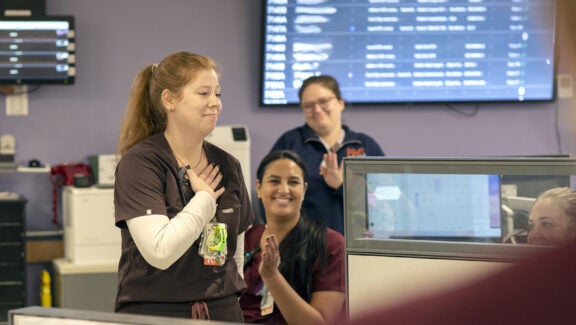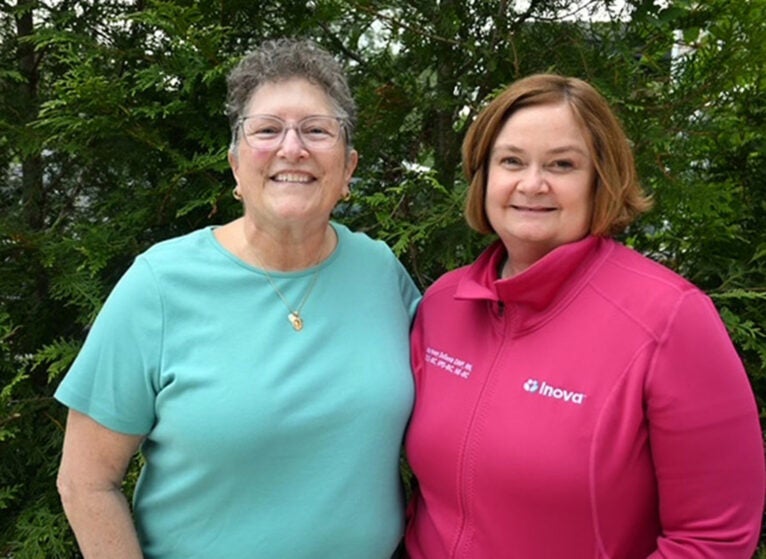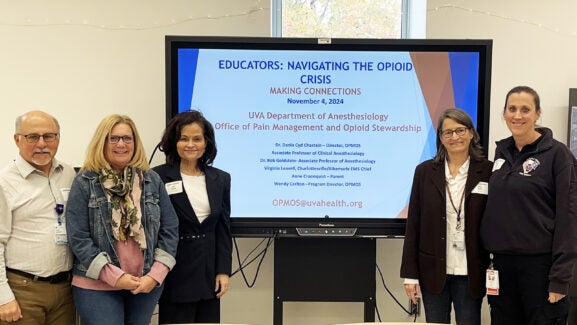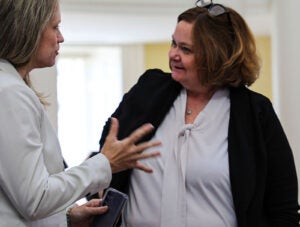

Maureen DeSena, right, with her first and favorite preceptor Ramona Tomato Bowman, BSN, RN. The two have been friends for more than 30 years, and met in the ED when DeSena was a new nurse.
A Commonsense Roadmap for RN Preceptors
Over the next decade, the nursing workforce is expected to expand by six percent, growth fueled almost entirely by new novice nurses. At the same time, veteran nurses are reducing their hours or exiting the profession, leaving what the Nursing Executive Center calls an “experience complexity gap.” Those factors mean that many nursing students are being precepted by clinical nurse preceptors with less experience, even as few consistent, formal structures exist to guide how they educate their students.
“Nurse leaders are asking novice nurses possessing less knowledge/experience as a preceptor to support student nurses,” explained DNP graduate and Inova clinical nurse specialist Maureen DeSena (DNP '25). “Regulations state that preceptors need to provide evidence of competence to supervise clinical experience ... yet there is not a definition of what competence means,” which can lead to frustration, negative experiences, and costly nurse turnover.
When precepting goes well — what DeSena, Senior Director of Nursing Professional Development and Program Director of Inova's practice transition accreditation program calls a “best-case scenario” — the relationships are powerful, affirming, and sometimes life-long. When preceptors lack experience, role clarity, or are overwhelmed with day-to-day tasks and their bedside teaching loads, it’s a lost opportunity, DeSena said, both for healthcare institutions seeking new hires and for students looking for permanent employment.
DeSena sat down to answer questions about her favorite preceptor, precepting as a retention tool, and how her novel preceptor “roadmap” — based on a Mayo Clinic model — helps provide direction in these important learning spaces in an increasingly complex healthcare environment.
What made you interested in doing a project focused on preceptors?
In my job, I work with a lot of nursing schools. For health systems, finding preceptors for students is great because it gives organizations a glimpse at people who would be good hires. It’s also a chance for the students to see what they think of an organization. It’s mutually beneficial. And it’s a fact, too, that many preceptors are relatively new nurses, and they don’t necessarily know what they’re doing. They’re the ones that call me and ask, “Do you have guidance?”
We do a lot of telling preceptors, “Thou shall,” and “Thou shall not” kinds of advice ... as in, “Let nursing students do blood pressures, but not IVs.” Schools provide guidelines for preceptors, but they’re often inconsistent, school to school, and in documents that are long and cumbersome, and provide too much information, and so they don’t get used. Clinical nurses who are preceptors just don’t have a lot of time. So many times, preceptors are just out there with the students, and no one knows what to do, what’s expected.
In 2022, I went to a conference — the Association of Nursing Professional Development — and I was sitting in a session with Dr. Ellen Joswiak from the Mayo Clinic. She talked about developing a guideline for preceptors to use when precepting senior nursing students ... and I nearly fell out of my seat I was so excited. Literally, the next day, I got into the elevator, and there’s Ellen. I said, “Hi, I’m Maureen, so nice to meet you. I do what you talked about for a living and want to try what you created in my organization. By the way, I’m in school, and I’ve love to keep in touch. Come see my presentation.”
Not only did she come to my presentation at that conference, as I progressed through the DNP program at UVA, and got closer to a proposal for my own capstone project, she mentored me. She even joined on Zoom for my presentation in the Rotunda earlier this year.
What kinds of preceptors did you have as a nursing student?
I had a best-case scenario, and maybe that’s why I’m so passionate about this. I started in the ED as a new graduate nurse 30 years ago, and two weeks ago, I went to dinner with the preceptor I had there. We’re still in touch and see each other all the time. It was 1994. They’d hired me and another classmate in the ED and were so concerned about bringing in new graduates that they took a nurse manager out of staffing to ensure we were prepared. That was my preceptor — now my friend, too.
She was and is a strong nurse. There wasn’t any specialty training like we have now ... but the hospital did come together and kind of wrapped their arms around us because they wanted us to be successful. Every week during those early days I had resource time, and staff nurses pulled me out of rotation and taught me things. Later, when I was asked to precept students of my own, I found I really loved it. I know what “good” precepting looked like because I had it myself. I found, too, that I liked teaching people how to do things; and having had a strong mentored experience myself makes all the difference.
What happens when nursing students have poor clinical experiences with preceptors?
It’s an opportunity missed. I had a single day in the OR when I was a nursing student, and I stood in the corner, and no one talked to me. It was 30 years ago, and I still have a bad taste in my mouth. It made me realize that I wanted to influence the clinical environment to really look at retention and support of preceptors and the students they mentor.
Describe, please, TSAM® and the approach you took with your project.
Using the Mayo Clinic’s tiered skills acquisition model (TSAM®), there are three components that provide a roadmap to guide nurse preceptors in their interactions with students: a model for a continuous partnership, a movement to have students perform skills that progress from simple to complex, and having resource time. Resource time was not part of this project due to time constraints involving student hours.
The traditional way of orienting a nurse is, “OK, you’re going to take this one patient out of my four and do everything.” That’s the incremental model. TSAM® ensures that there is a continuous partnership between the preceptors and students. In this model, as the preceptor is performing tasks, they’re talking out loud, talking through everything. This tool outlines these behaviors and gives preceptors an idea of how to structure their time with their students. It’s a how-to. On day one, give your students a tour, talk to them about your schedule, ask them how they like to learn and talk. Make it welcoming!
You start off doing simple skills with the student, like taking vital signs, and documenting your findings. Once preceptors determine that students have had enough experience, they move to the next tier, which involves more complex skills — giving medications and assessing doctors’ orders — while still practicing skills from the first tier. It’s the cognitive load theory. We can only hold so many pieces of information in our brains, before things move from short-term to long-term memory. It’s why these repeated skills, simple to complex, help you become proficient and are better for learning.
What did the nurse preceptors in your study say about the toolkit you created?
Twenty-four preceptors with mixed levels of experience piloted the new tool last fall. We had novice nurse preceptors, including seven with fewer than two years’ experience. Most had no prior training to be preceptors whatsoever. Of those, 100% surveyed said they would perform the role of preceptor in the future using a tool like the one I created.
Nurse-preceptors with more experience said they liked the tool because it provided them with a roadmap. Students can be hesitant, hang back in the shadows, be shy. Having the tool in front of them, these preceptors said, helped them say to their students, “OK, here’s how we’re going to organize our day.” Ninety-four percent from this group reported being satisfied or extremely satisfied with the tool.
Does precepting benefit nurses? Is it a retention tool that keeps them in the game, so to speak?
Oh, my goodness, yes! Precepting helps you grow professionally, it helps these nurses become the expert, as a teacher, because you’re verifying what you know, and if you don’t know something, you go and research it. You become better at what you do.
What’s come out of your project and capstone?
It really provides a framework for developing a relationship between healthcare organizations and nursing schools. We want institutions to be intentionally interested in this dyad, and to consider a consistent approach to guiding preceptors. Some schools provide tools to preceptors, but the language and requirements are not the same. At Inova, we work with 15 or 16 different nursing schools across Virginia, and they could send us 15 or 16 different PowerPoints and packages, which makes it confusing for our nurse preceptors. Schools each have different requirements and preceptors are charged with keeping all this straight and navigating the differences.
My daughter is a new nurse, and she’s had a lot of variation and inconsistency [in how she’s instructed as a preceptor], so I think about this a lot. In nursing and medicine, a lot of experienced people are leaving or have left ... the clinical environment is so fast-paced and demanding and complex ... Novice nurses coming in are often not staying long. What we have is a gap of experience, which is why it’s so important to ensure that novice nurses and nurses who are precepting them have the support and tools they need.
We can do better by them. That will help across and throughout nursing during what is a critical time.
Latest News




